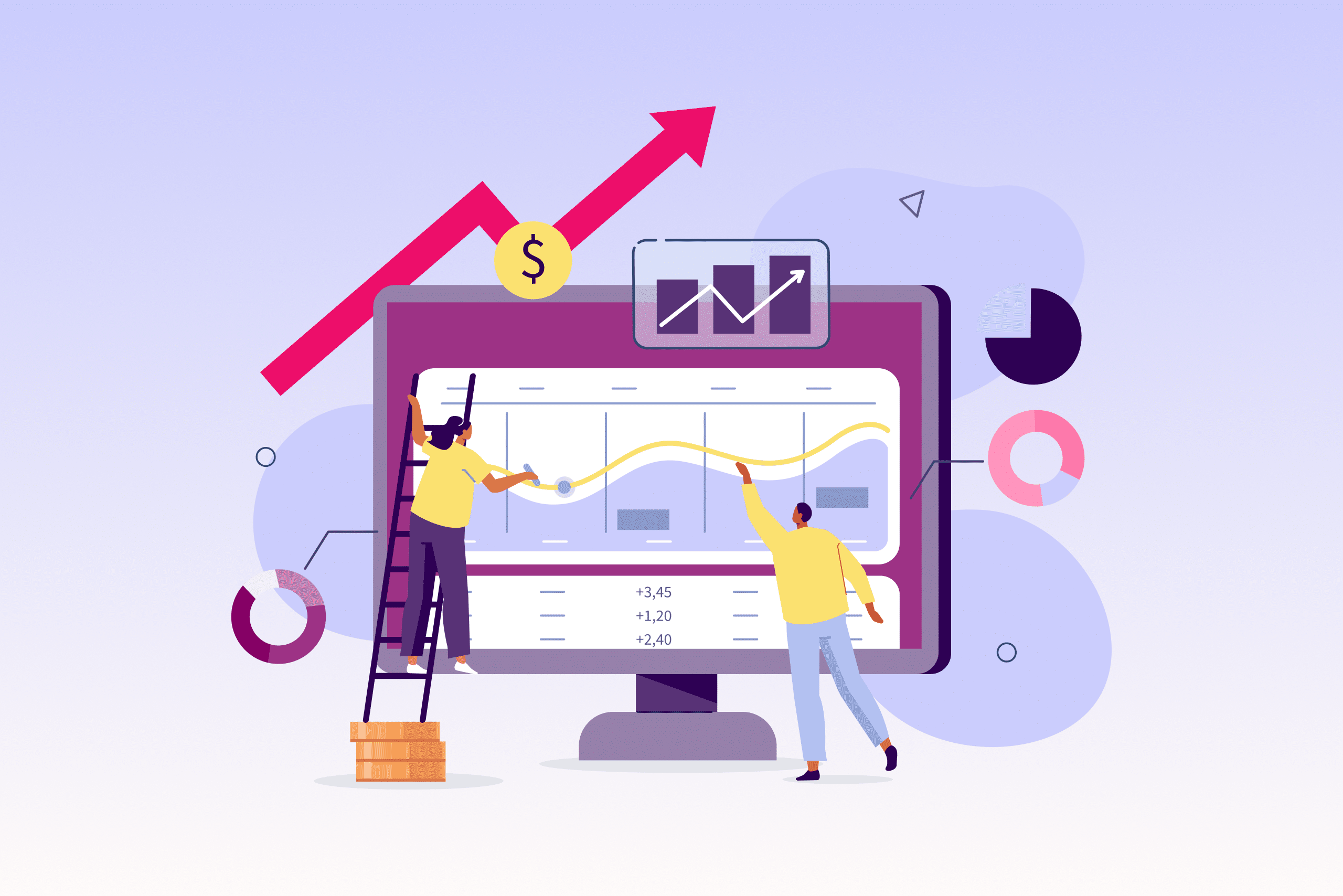In business, pricing plays a big role in driving profits. After all, how much customers are willing to pay for your products in relation to production and operating expenses directly impacts your bottom line. However, many businesses approach pricing as a one-time activity rather than an ongoing opportunity. In reality, companies can leverage everything from seasonality to inventory levels to set ever-changing optimal prices for their products.
With eCommerce dynamic pricing—a strategy that involves changing prices based on market conditions—it’s possible to stay competitive while keeping a keen eye on maximizing revenue.
Dynamic Pricing in eCommerce
Dynamic pricing in eCommerce works by changing prices over time in response to external factors. Traditionally, prices in brick-and-mortar establishments stay mostly flat indefinitely. However, dynamic prices are always changing in response to any number of market impacts.
How Dynamic Pricing Algorithms Work
Algorithms used for dynamic pricing work by analyzing data sets, like seasonal trends or product performance in comparison to competitors, to make pricing adjustments. The algorithms then learn over time, refining strategies as the market landscape changes.
How Dynamic Pricing Maximizes Profits for Online Sellers
The objective of dynamic pricing is to maximize profit for online sellers without compromising customer base or losing ground to the competition. This occurs in a variety of ways.
Increased Control Over Pricing Strategy
Rather than setting product prices once and never looking back, employing dynamic pricing increases control with an educated approach. Pricing changes aren’t made arbitrarily but rather with the backing of data and analysis.
More Flexibility
Standard pricing is very rigid. It means keeping your products boxed into one price point, even if that reduces competitiveness. Dynamic pricing changes with the sales environment depending on your business priorities, which means the ultimate flexibility to take advantage of new opportunities whenever they arise.
How to Implement Dynamic Pricing in eCommerce
Dynamic pricing for eCommerce businesses varies based on specific sectors and pre-existing knowledge. However, the core tactics are the same across the board, so let’s get started.
Collect Historical Data
Historical sales data is one of the most important datasets in building pricing models. While markets will shift over time in a way that might not be accounted for by historical trends, this still ensures an informed way to start.
Look for things like periods of high sales as well as when demand is lowest, the peak pricing points that don’t discourage sales, and how the competition is performing.
Create Demand and Profit Models
Part of implementing an effective dynamic pricing strategy involves finding the sweet spot between customer demand and profit potential. While pricing products as expensive as possible to drive revenue sounds good in theory, there are times when customers will hesitate to pick your brand over the competition. On the other hand, dropping prices to increase sales only works if you’re still able to turn a profit.
Demand and profit models can help you determine minimum and maximum pricing to improve profitability while still capitalizing on demand.
Develop Your Strategy
Once you have an idea of how your products are priced in the market and what historical trends apply, you can work to develop an optimal range. Whether this means focusing solely on seasonality or leveraging competitor trends to gain an advantage will depend on both the nature of your business and what you’re trying to achieve.
Analyze and Forecast
It’s best to understand how pricing may specifically alter the ways in which your business operates before making any strategic changes. This can require some analysis to forecast potential risks and opportunities as a result of dynamic pricing. This may mean estimating product prices throughout the year to project revenue, coupling pricing changes with trends in demand to estimate an impact on profits and losses, or determining pain points in current practices that pricing might address.
Adjust Pricing
With a strategy in hand, as well as analyses forecasting future expectations, you can then move forward with adjusting pricing. While this can be done manually, it’s generally best to leverage an eCommerce dynamic pricing tool to do the hard part for you. These tools, which can be part of third-party platforms or built into eCommerce marketplaces, such as Amazon’s Seller Central, can often be programmed to target specific goals.
Monitor the Data
Access to data is only as useful as what you do with it. Ignoring new insights in favor of historical trends can mean leaving money on the table, so ensure that you’re keeping an eye on how sales are performing now that a dynamic model is in place. Think broadly when collecting information and using it to draw conclusions; there are many different metrics to consider, from profit margin to visibility in SERPs.
Update Your Strategy Over Time
New trends in data, regardless of your area of emphasis, are best used to inform future decision-making. Dynamic pricing models should be regularly updated to ensure pricing shifts are being driven by the most accurate data possible.
Depending on the tools in use, this might happen automatically as pricing algorithms incorporate changes in a marketplace or may require manual tweaks to the process in place.
Dynamic Pricing Tools
While eCommerce dynamic pricing can theoretically be managed independently, advanced dynamic pricing software can use data to improve strategies and fine-tune results. Rather than doing all of the research and analysis yourself, AI-leveraged tools can create methodologies that will improve results.
Most platforms offer ways to help users streamline their goals, and once priorities are determined, metrics like profit per session (PPS), total sales, BSR, and conversion rates can be analyzed to determine how to best implement automated pricing adjustments. After targets have been identified and algorithms are aligned with intended results, these kinds of tools can adjust pricing hour by hour, using a wealth of historical and market-driven information to set ideal rates.
Implementing Dynamic Pricing on Marketplaces
How you choose to implement dynamic pricing on eCommerce marketplaces will depend on your sales strategy and the tools you have available. This could be as simple as tweaking prices manually on Walmart.com or using Amazon’s pricing tool for automated price changes when needs arise.
However, as mentioned above, dynamic pricing tools don’t have to be limited to marketplace interfaces. For large-scale sellers or those with brand growth as an objective, third-party tools like Trellis may be a better opportunity.
What Results Can Online Sellers Expect with Dynamic Pricing?
There are numerous advantages that sellers will be able to see with dynamic pricing in place. These include:
- Improved profits and product margins: With the ability to optimize pricing in a way that drives performance, businesses can save money and reach revenue targets faster.
- More efficient inventory management: Dynamic pricing can account for inventory levels and trends, helping guide stocking and production while minimizing waste.
- Increased customer satisfaction: With the ability to offer better pricing in periods of high competition, customers will learn to count on you for cost savings that other players in the marketplace can’t match.
- Getting ahead of the competition: While others in the same space are likely to leverage pricing tools as well, choosing the right resources and understanding pricing strategies can put you ahead of your competitors.
Implement Intelligent Dynamic Pricing with Trellis
Dynamic pricing on Amazon and other eCommerce marketplaces should be a central element of business operations. With the ability to improve profit margins, competitive advantage, and cost savings for your company, the right approach to pricing can offer big benefits. Your competitors will surely be doing the same, so failing to employ a well-reasoned strategy can mean falling behind in a big way.
However, the easily available tools don’t always mean the right ones for your business. For brands that want to go above and beyond, more advanced eCommerce merchandising options, like the powerful dashboard offered by Trellis, can deliver unparalleled performance. With a full suite of resources with a unique approach to the four Ps—Product, Price, Promotion, and Place—sellers have the opportunity to leverage sophisticated AI-driven tools to see the best possible results. Start a free trial today to test Dynamic Pricing for your business.



